Face Detection and Recognition¶
-
SDK.detect_faces(self: tfsdk.SDK) → List[tfsdk.FaceBoxAndLandmarks]¶ Detect all the faces in the image and return the bounding boxes and facial landmarks. This method has a small false positive rate. To reduce the false positive rate to near zero, filter out faces with score lower than 0.90. Alternatively, you can use the
FACEDETECTIONFILTERconfiguration option to filter the detected faces. The face detector has a detection scale range of about 5 octaves.tfsdk.ConfigurationOptions.smallest_face_heightdetermines the lower of the detection scale range. E.g., settingtfsdk.ConfigurationOptions.smallest_face_heightto 40 pixels yields the detection scale range of ~40 pixels to 1280 (=40x2^5) pixels.- Returns
A list of
FaceBoxAndLandmarksrepresenting each of the detected faces. If not faces are found, the list will be empty.
The recall and precision of the face detection algorithm on the WIDER FACE dataset:
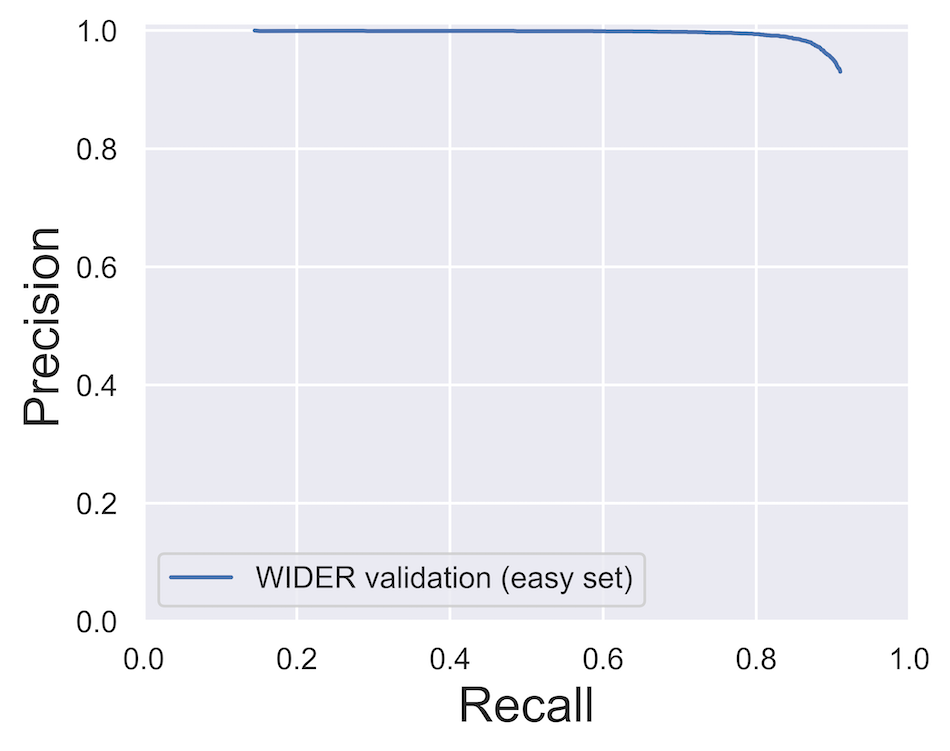
The effect of face height on similarity score:
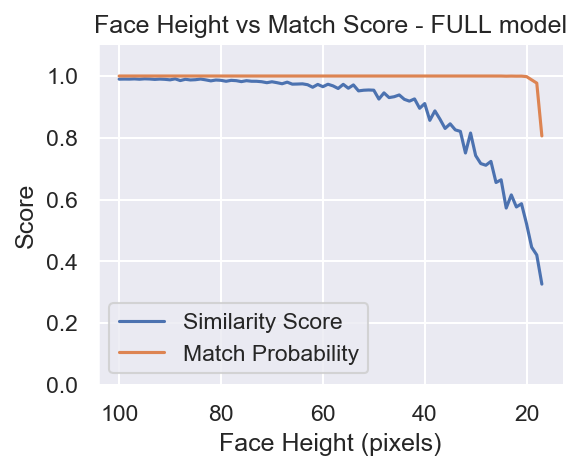
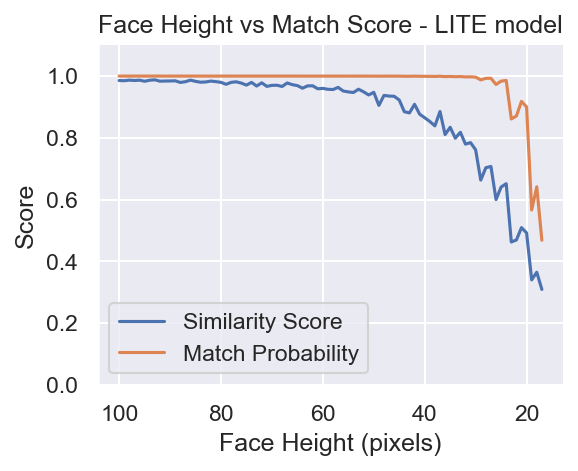
-
SDK.detect_largest_face(self: tfsdk.SDK) → Tuple[bool, tfsdk.FaceBoxAndLandmarks]¶ Detect the largest face in the image. This method has a small false positive rate. To reduce the false positive rate to near zero, filter out faces with score lower than 0.90. Alternatively, you can use the
FACEDETECTIONFILTERconfiguration option to filter the detected faces. Seetfsdk.SDK.detect_faces()for detection range.- Returns
The
ERRORCODEand a bool indicating if a face was detected, in that order.
Deprecated since version 0.17: Use tfsdk.SDK.detect_faces() or tfsdk.SDK.detect_largest_face() instead.
-
SDK.get_face_landmarks(self: tfsdk.SDK, face_box_and_landmarks: tfsdk.FaceBoxAndLandmarks) → Tuple[tfsdk.ERRORCODE, List[Trueface::Point<int>]]¶ Obtain the 106 face landmarks.
- Parameters
face_box_and_landmarks -
tfsdk.FaceBoxAndLandmarksreturned bytfsdk.SDK.detect_faces()ortfsdk.SDK.detect_largest_face().- Returns
The
tfsdk.ERRORCODEand list of the 106 face landmark points, returned in that order.
Obtain the 106 face landmarks.
The order of the face landmarks:
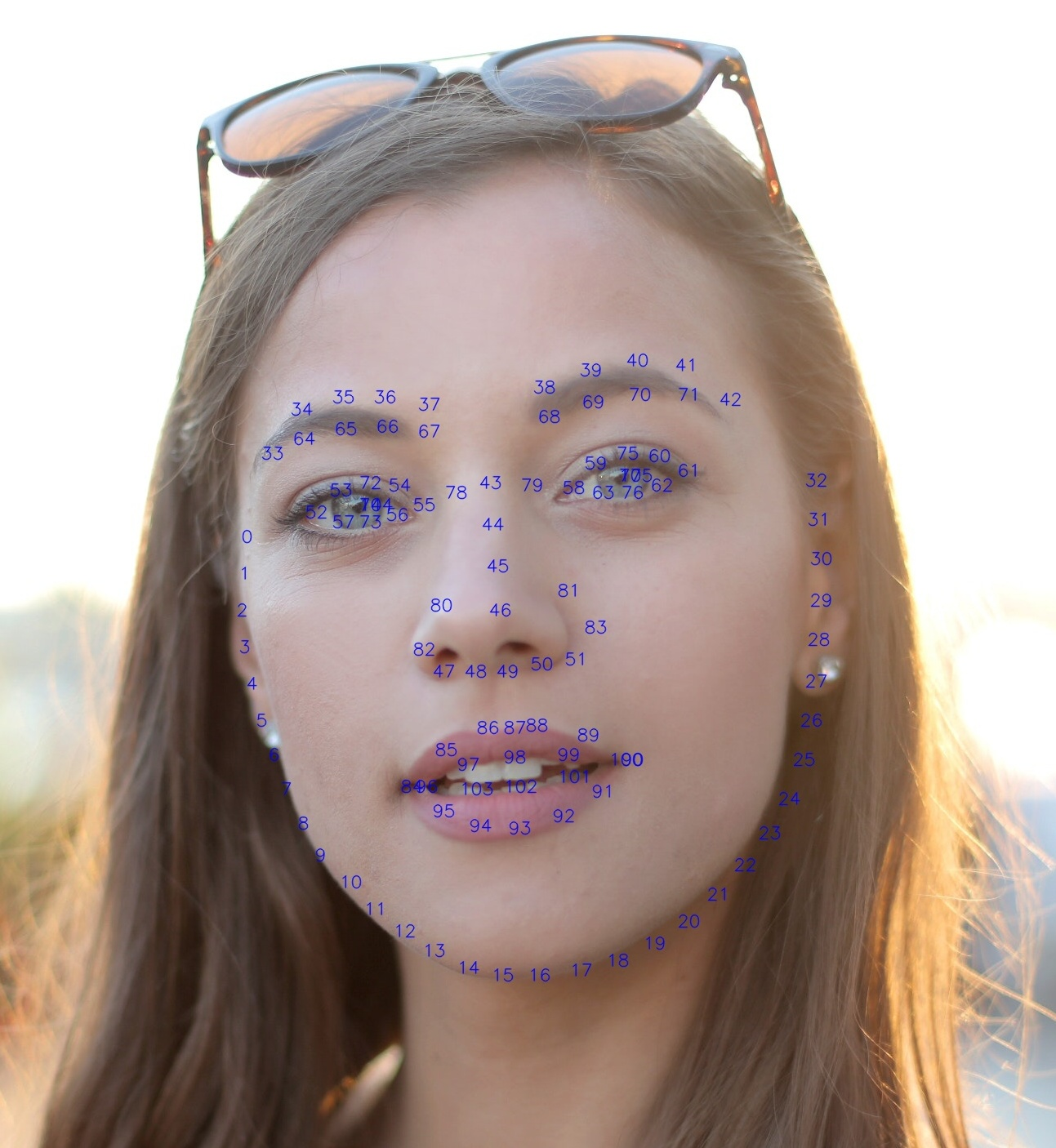
-
SDK.extract_aligned_face(*args, **kwargs)¶ Overloaded function.
extract_aligned_face(self: tfsdk.SDK, face_box_and_landmarks: tfsdk.FaceBoxAndLandmarks, margin_left: int = 0, margin_top: int = 0, margin_right: int = 0, margin_bottom: int = 0, scale: float = 1.0) -> numpy.ndarray[uint8]
Extract the aligned face chip in a Numpy array. Changing the margins and scale will change the face chip size. If using the face chip with Trueface algorithms (ex face recognition), do not change the default margin and scale values.
- Parameters
face_box_and_landmarks - the
tfsdk.FaceBoxAndLandmarksreturned bytfsdk.SDK.detect_largest_face()ortfsdk.SDK.detect_faces().margin_left - adds a margin to the left side of the face chip (default = 0).
margin_top - adds a margin to the top side of the face chip (default = 0).
margin_right - adds a margin to the right side of the face chip (default = 0).
margin_bottom - adds a margin to the bottom side of the face chip (default = 0).
scale - changes the scale of the face chip (default = 1).
- Returns
Returns a numpy array containing the face chip.
extract_aligned_face(self: tfsdk.SDK, buffer_pointer: int, face_box_and_landmarks: tfsdk.FaceBoxAndLandmarks, margin_left: int = 0, margin_top: int = 0, margin_right: int = 0, margin_bottom: int = 0, scale: float = 1.0) -> tfsdk.ERRORCODE
Extract the aligned face chip in a Numpy array. Changing the margins and scale will change the face chip size. If using the face chip with Trueface algorithms (ex face recognition), do not change the default margin and scale values. This function override requires the caller to allocate the memory required for the face chip. The buffer size can be computed as follows: width = int((112+margin_left+margin_right)*scale), height = int((112+margin_top+margin_bottom)*scale), and therefore the buffer size is computed as: width * height * 3
- Parameters
buffer_pointer - a buffer allocated by the caller which the face chip will be written to.
face_box_and_landmarks - the
tfsdk.FaceBoxAndLandmarksreturned bytfsdk.SDK.detect_largest_face()ortfsdk.SDK.detect_faces().margin_left - adds a margin to the left side of the face chip (default = 0).
margin_top - adds a margin to the top side of the face chip (default = 0).
margin_right - adds a margin to the right side of the face chip (default = 0).
margin_bottom - adds a margin to the bottom side of the face chip (default = 0).
scale - changes the scale of the face chip (default = 1).
- Returns
The
tfsdk.ERRORCODE.
-
SDK.save_face_image(self: tfsdk.SDK, face_image: numpy.ndarray[uint8], filepath: str) → None¶ Store the face image in JPEG file.
- Parameters
face_image - the face chip as a numpy array, must be 112x112 pixels, therefore use the default margin and scale parameters when calling
tfsdk.SDK.extract_aligned_face().filepath - relative or absolute file path without a file extension.
- Returns
Error code, see
ERRORCODE
-
SDK.get_face_feature_vector(*args, **kwargs)¶ Overloaded function.
get_face_feature_vector(self: tfsdk.SDK, aligned_face_image: numpy.ndarray[uint8]) -> Tuple[tfsdk.ERRORCODE, tfsdk.Faceprint]
Return the corresponding feature vector for the given aligned face image.
- Parameters
aligned_face_image - aligned face chip as numpy array. Face chip must have size of 112x112 pixels, therefore use the default margin and scale parameters when calling
tfsdk.SDK.extract_aligned_face().- Returns
The
ERRORCODEandtfsdk.Faceprint, in that order.
get_face_feature_vector(self: tfsdk.SDK, face_box_and_landmarks: tfsdk.FaceBoxAndLandmarks) -> Tuple[tfsdk.ERRORCODE, tfsdk.Faceprint]
Extract the face feature vector from the face box.
- Parameters
face_box_and_landmarks - face box and landmarks returned by
tfsdk.SDK.detect_faces()ortfsdk.SDK.detect_largest_face().- Returns
The
ERRORCODEandtfsdk.Faceprint, in that order.
-
SDK.get_face_feature_vectors(*args, **kwargs)¶ Overloaded function.
get_face_feature_vectors(self: tfsdk.SDK, aligned_face_images: List[numpy.ndarray[uint8]]) -> Tuple[tfsdk.ERRORCODE, List[tfsdk.Faceprint]]
Extract the face feature vectors from the aligned face images.
- Parameters
aligned_face_images - a list of numpy array aligned face image buffers.
- Returns
The
ERRORCODEand a list oftfsdk.Faceprint, in that order.
get_face_feature_vectors(self: tfsdk.SDK, aligned_face_images: List[int]) -> Tuple[tfsdk.ERRORCODE, List[tfsdk.Faceprint]]
Extract the face feature vectors from the aligned face images.
- Parameters
aligned_face_images - a pointer to a list of aligned face image buffers.
- Returns
The
ERRORCODEand a list oftfsdk.Faceprint, in that order.
-
SDK.get_largest_face_feature_vector(self: tfsdk.SDK) → Tuple[tfsdk.ERRORCODE, tfsdk.Faceprint, bool]¶ Detect the largest face in the image and return the corresponding feature vector.
- Returns
The
ERRORCODE,tfsdk.Faceprint, and a bool indicating if a face was detected, in that order. If not face was detected in the image, the Faceprint will be empty.
-
static
SDK.faceprint_to_json(faceprint: tfsdk.Faceprint) → str¶ Convert a
tfsdk.Faceprintinto a json string.- Parameters
faceprint – the
tfsdk.Faceprintto convert to a string.- Returns
The string representation of the
tfsdk.Faceprint
-
static
SDK.json_to_faceprint(json_string: str) → Tuple[tfsdk.ERRORCODE, tfsdk.Faceprint]¶ Create a
tfsdk.Faceprintfrom a json string.- Parameters
json_string – the json string representation of a
tfsdk.Faceprint, generated from thetfsdk.SDK.json_to_faceprint()function.- Returns
The
tfsdk.Faceprintgenerated from the json string.
-
SDK.get_similarity(self: tfsdk.SDK, feature_vector_1: tfsdk.Faceprint, feature_vector_2: tfsdk.Faceprint) → Tuple[tfsdk.ERRORCODE, float, float]¶ Compute the similarity of the given feature vectors.
- Parameters
feature_vector_1 – the first Faceprint to be compared.
feature_vector_2 – the second Faceprint to be compared.
- Returns
The
ERRORCODE, match probability and similairty score, in that order. The match probability is the probability that the two faces feature vectors are a match, while the similairty is the computed similairty score.
-
SDK.estimate_face_image_quality(self: tfsdk.SDK, aligned_face_image: numpy.ndarray[uint8]) → Tuple[tfsdk.ERRORCODE, float]¶ Estimate the image quality for face recognition.
- Parameters
aligned_face_image - the numpy aligned face chip image returned by
tfsdk.SDK.extract_aligned_face().- Returns
The
ERRORCODEand face quality score, in that order. The quality score is between 0 and 1, 1 being perfect quality.
-
SDK.estimate_head_orientation(self: tfsdk.SDK, face_box_and_landmarks: tfsdk.FaceBoxAndLandmarks) → Tuple[tfsdk.ERRORCODE, float, float, float]¶ Estimate the head orientation using the detected facial landmarks.
- Parameters
face_box_and_landmarks - the
tfsdk.FaceBoxAndLandmarksreturned bytfsdk.SDK.detect_largest_face()ortfsdk.SDK.detect_faces().- Returns
The
ERRORCODE, yaw, pitch, roll, in that order. Angles are in radians.
The accuracy of this method is estimated using 1920x1080 pixel test images. A test image:
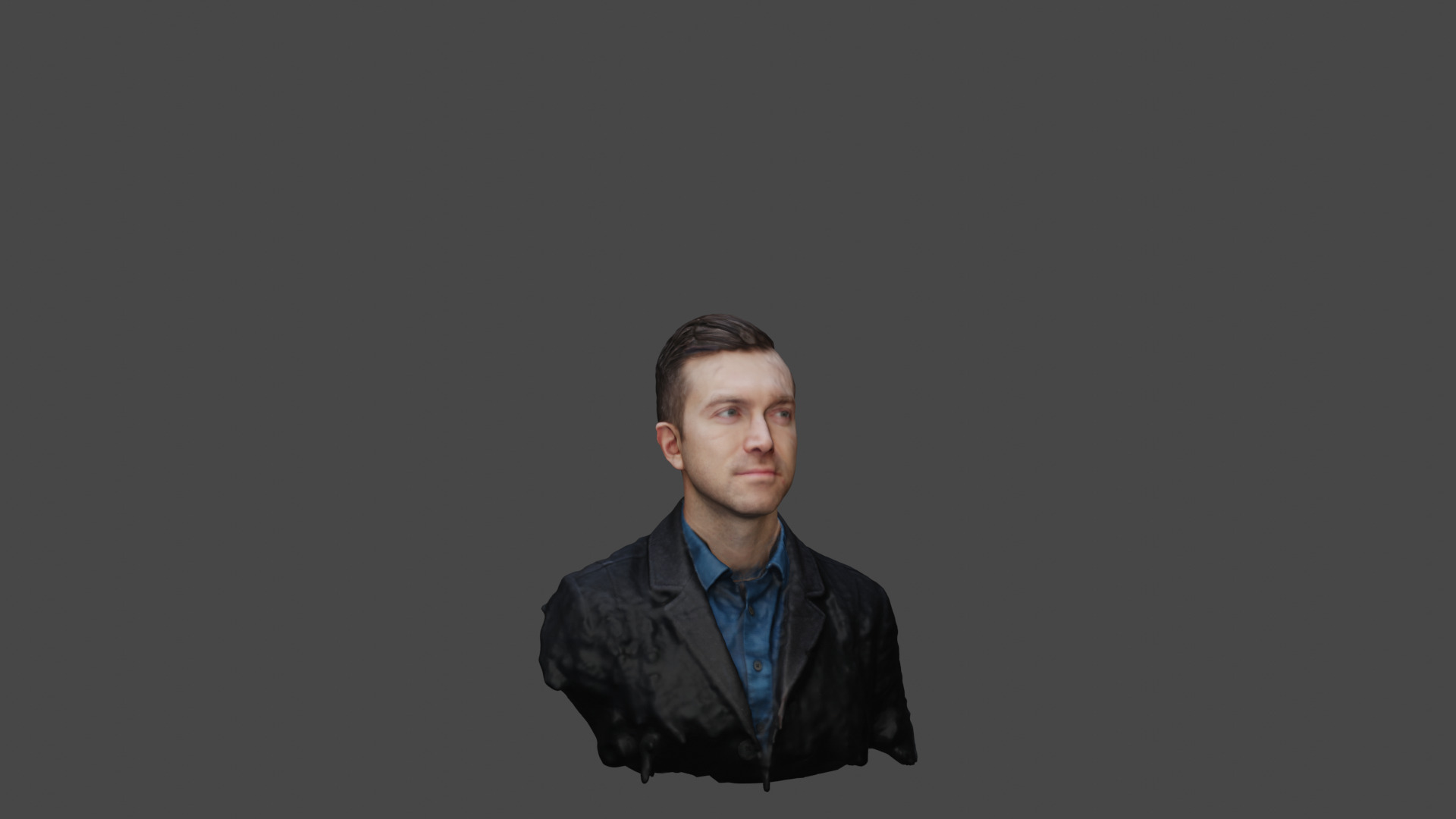
The accuracy of the head orientation estimation:
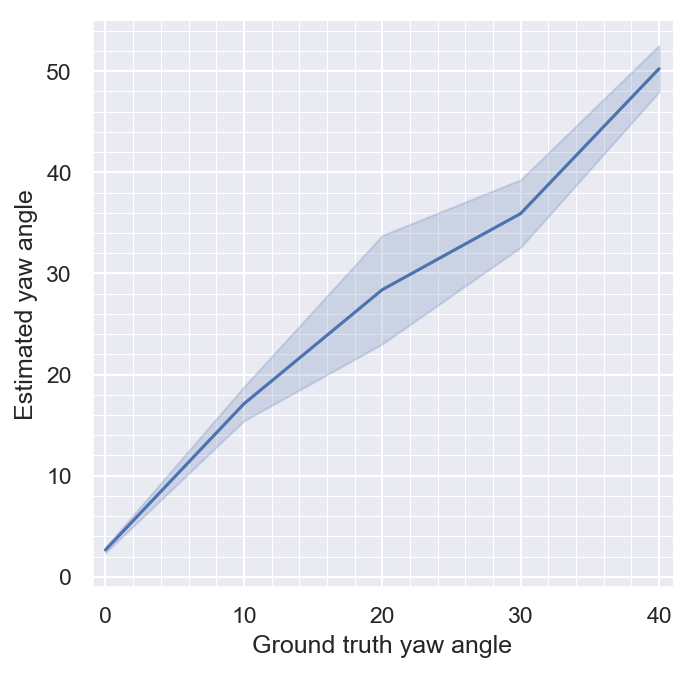
The effect of the face yaw angle on match similarity can be seen in the following figure:
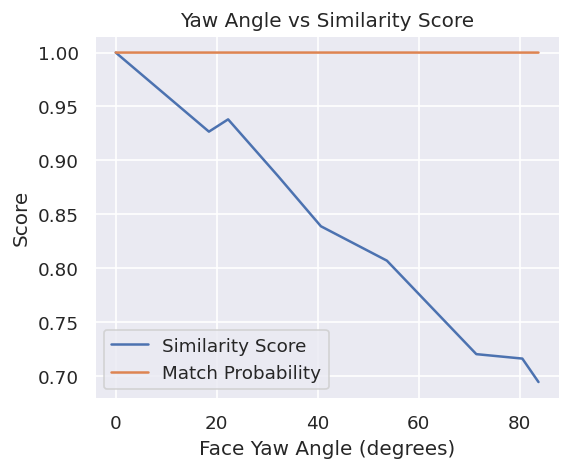
The effect of the face pitch angle on match similarity can be seen in the following figure:
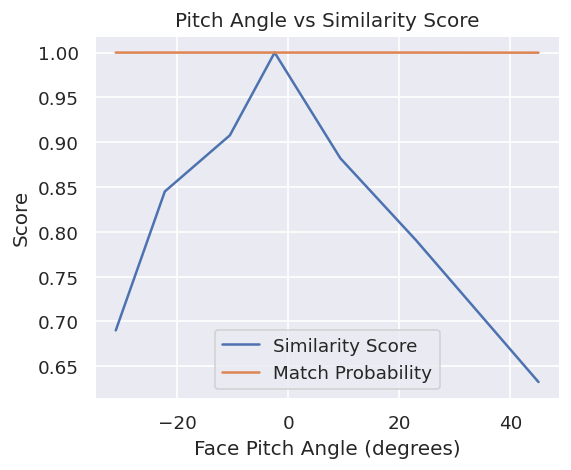
-
class
tfsdk.FaceBoxAndLandmarks¶ -
-
property
landmarks¶ The list of facial landmark points (
Point) in this order: left eye, right eye, nose, left mouth corner, right mouth corner.
-
property
score¶ Likelihood of this being a true positive; a value lower than 0.85 indicates a high chance of being a false positive.
-
property
-
class
tfsdk.Faceprint¶ -
compare(self: tfsdk.Faceprint, fp: tfsdk.Faceprint) → Tuple[tfsdk.ERRORCODE, float, float]¶ Compare the similarity between two
tfsdk.Faceprint. The same astfsdk.SDK.get_similairty()- Parameters
fp - the
tfsdk.Faceprintto compare against.- Returns
The
ERRORCODE, match probability, and similarity score, in that order.
-
property
feature_vector¶ Vector of floats which describe the face.
-
get_quantized_vector(self: tfsdk.Faceprint) → numpy.ndarray[int16]¶ Return the feature vector as a list of 16-bit integers. This is useful for when the
tfsdk.ModelOptions.fr_vector_compressionoption is enabled and you require an integer representation of the quantized feature vector.- Returns
A 16-bit numpy array representation of the
tfsdk.Faceprint.feature_vector.
-
property
model_name¶ Name of model used to generate feature vector.
-
property
model_options¶ Additional options used for generating the feature vector.
-
property
sdk_version¶ SDK version used to generate feature vector.
-
set_quantized_vector(self: tfsdk.Faceprint, quantized_feature_vector: numpy.ndarray[int16]) → None¶ Populate the
tfsdk.Faceprint.feature_vector()from a quantized 16-bit numpy array generated bytfsdk.Faceprint.get_quanitzed_vector()- Parameters
quantized_feature_vector - the 16-bit numpy array feature vector.
-
-
class
tfsdk.ModelOptions¶ -
property
fr_vector_compression¶ Indicates if the
tfsdk.ConfigurationOptions.fr_vector_compressionoption was enabled when generating the feature vector.
-
property